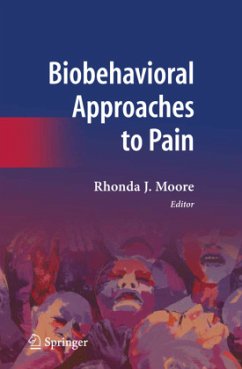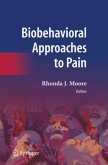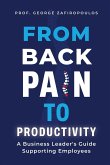Pain is a common symptom, yet it is frequently underevaluated and undertreated. It is difficult to define, describe-and sometimes to prove. It's pain, and suspicions of exaggerations often add further insult to a patients' injuries. Biobehavioral Approaches to Pain translates this highly subjective experience-and its physical, psychological, social, and cultural dimensions-into practical insights key to transforming the field of pain management.
This pathbreaking volume synthesizes a rich knowledge base from across disciplines, including neurobiologic, genetic, biobehavioral, clinical, narrative, substance abuse, health services,ethical and policy perspectives, for a deeper understanding of the impact of pain on individual lives and the larger society. Its international panel of contributors highlights special issues and review best practice guidelines, from placebo effects to cancer, Whiplash Associated Disorders to pain imaging to complementary medicine, phantom limb pain to gene therapies to AIDS. Among the topics covered:
The distinction between acute and chronic pain: is it clinically useful?
Improving clinical assessment of patients with pain.
Age and sex differences in pain.
The what, how and why of the placebo and nocebo effect
Psychosocial and partner-assisted biopsychosocial interventions for disease-related pain
Substance abuse issues in pain treatment.
The personal, social and economic costs of chronic pain.
Biobehavioral Approaches to Pain offers clinical and health professionals, psychologists, as well as specialists in pain management or palliative care, new directions in their ongoing dialogue with patients. Given the prevalence of pain in the general population, it should also interest researchers and students in the field ofpublic health.
This pathbreaking volume synthesizes a rich knowledge base from across disciplines, including neurobiologic, genetic, biobehavioral, clinical, narrative, substance abuse, health services,ethical and policy perspectives, for a deeper understanding of the impact of pain on individual lives and the larger society. Its international panel of contributors highlights special issues and review best practice guidelines, from placebo effects to cancer, Whiplash Associated Disorders to pain imaging to complementary medicine, phantom limb pain to gene therapies to AIDS. Among the topics covered:
The distinction between acute and chronic pain: is it clinically useful?
Improving clinical assessment of patients with pain.
Age and sex differences in pain.
The what, how and why of the placebo and nocebo effect
Psychosocial and partner-assisted biopsychosocial interventions for disease-related pain
Substance abuse issues in pain treatment.
The personal, social and economic costs of chronic pain.
Biobehavioral Approaches to Pain offers clinical and health professionals, psychologists, as well as specialists in pain management or palliative care, new directions in their ongoing dialogue with patients. Given the prevalence of pain in the general population, it should also interest researchers and students in the field ofpublic health.
From the reviews:
"Moore ... has put together a multidisciplinary and multidimensional examination of the complex phenomenon of pain that collectively is cognizant of the various molecular, neurophysical, biological, environmental, emotional, psychosocial, and societal factors that impact the human experience of pain and the treatment of pain. Aimed at scientists, policy analysts, and clinicians interested in a holistic understanding of pain, the 21 chapters she presents discuss the experience of pain and suffering from acute and chronic pain ... ." (SciTech Book News, March, 2009)
"This book describes pain in all of its facets within a multidisciplinary, biobehavioral framework, addressing management, evaluation, and treatment of pain as well. ... The audience is ... health professionals, psychologists, and specialists in pain management or palliative care, as well as researchers and students in the field of public health. ... This book is well written with helpful tables and figures. ... This is a thorough look at the issue of pain from a biobehavioral approach, which includes the interactive roles of various factors." (Gary B Kaniuk, Doody's Review Service, April, 2009)
"This book, edited by Rhonda Moore and including contributions from a multidisciplinary panel of experts in the field from many countries, follows this tradition. ... The organization of the chapters reflects the reality ... interaction of multiple notions and skills is required for the correct global assessment of patients with pain. The book's 21 chapters are generally comprehensive and well referenced. ... This book should be of interest to a large readership and could help to increase awareness of the specific features of chronic pain." (Didier Bouhassira, New England Journal of Medicine, Vol. 361 (2), July, 2009)
"Book is informative, as it tries to reach various disciplines that play crucial role in managing pain. ... The uniqueness of thetopics concerned is giving the meaning and explaining how they interact with one another. This makes the book more interesting and deepens the understanding. ... book offers wide scope for various specialties to work for the pain management and research. ... the book is good read!!" (T. S. Seemanthini, Disabilities and Impairments, Vol. 26 (2), 2012)
"Moore ... has put together a multidisciplinary and multidimensional examination of the complex phenomenon of pain that collectively is cognizant of the various molecular, neurophysical, biological, environmental, emotional, psychosocial, and societal factors that impact the human experience of pain and the treatment of pain. Aimed at scientists, policy analysts, and clinicians interested in a holistic understanding of pain, the 21 chapters she presents discuss the experience of pain and suffering from acute and chronic pain ... ." (SciTech Book News, March, 2009)
"This book describes pain in all of its facets within a multidisciplinary, biobehavioral framework, addressing management, evaluation, and treatment of pain as well. ... The audience is ... health professionals, psychologists, and specialists in pain management or palliative care, as well as researchers and students in the field of public health. ... This book is well written with helpful tables and figures. ... This is a thorough look at the issue of pain from a biobehavioral approach, which includes the interactive roles of various factors." (Gary B Kaniuk, Doody's Review Service, April, 2009)
"This book, edited by Rhonda Moore and including contributions from a multidisciplinary panel of experts in the field from many countries, follows this tradition. ... The organization of the chapters reflects the reality ... interaction of multiple notions and skills is required for the correct global assessment of patients with pain. The book's 21 chapters are generally comprehensive and well referenced. ... This book should be of interest to a large readership and could help to increase awareness of the specific features of chronic pain." (Didier Bouhassira, New England Journal of Medicine, Vol. 361 (2), July, 2009)
"Book is informative, as it tries to reach various disciplines that play crucial role in managing pain. ... The uniqueness of thetopics concerned is giving the meaning and explaining how they interact with one another. This makes the book more interesting and deepens the understanding. ... book offers wide scope for various specialties to work for the pain management and research. ... the book is good read!!" (T. S. Seemanthini, Disabilities and Impairments, Vol. 26 (2), 2012)









